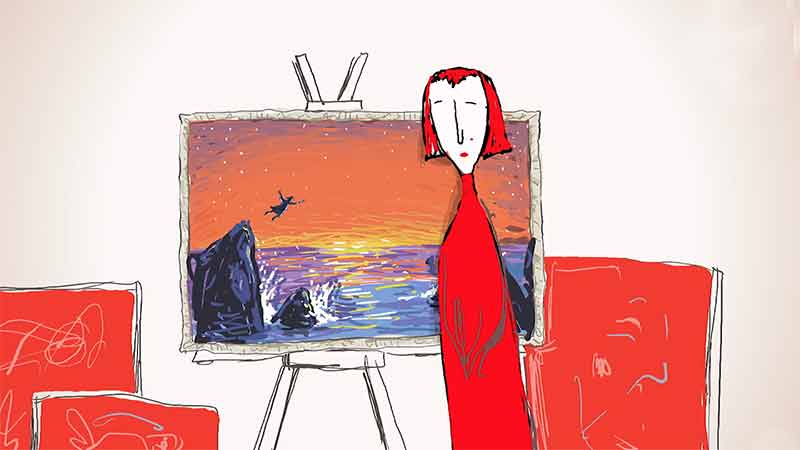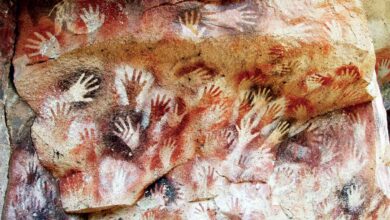Art Means

Art has a history as old as humanity. The art history of nations is a diagram of their talents, abilities, ideas, perseverance, perseverance and endurance.
Discovered works from different classes of the earth reflect the different civilizations and geographical conditions and the influences of religion, politics, economy, social governance system and the special living conditions of nations.
The present article, which begins in prehistoric times and ends in a concise way, dates back to the early Middle Ages. Like the cinematic of the illustrated arts of the nations: Assyria, Chaldea, Sumer, Iran, Greece, Rome, India and China, and the reader as far as the discovery of civilizations and their ups and downs as far as it has been revealed to us. Informs.
Archeology is a very important and useful field, especially in countries like Iran, which have a great and ancient civilization, because apart from discovering the works of ancestral genius and receiving the secret of resistance, the ups and downs of life and contact with different nations have reached the stage of emergence. And it causes national pride and strengthens the psychological strength and esoteric pride of the present and future generations. It is also very important in terms of the good flow of life and contact with different nations of the world and attracting tourists and the prosperity of the country’s economic market…. The more attention is paid to this field, the more the children of this land and water and ancestors will be scientifically qualified to explore and discover, and make the country needless of foreign experts who never have this interest and disinterestedness and knowledge of local customs. .
What is art? It is a very complex and complex debate that has been thought about for centuries, and what every philosopher has stated as a theory.
“Art is one thing and beauty is another,” says Ferdinand Brunetiere
Gastala believes that art is man-made.
An esthetician says: Man was an artist before he was a scientist, because the rule of imagination precedes the rule of reason and experience.
An esthetician says: Artwork is the product of knowledge through ability.
An esthetician says: Art is pleasure and salinity that has found objectivity and subjectivity.
An esthetician says: Art is not just a show, or an embodiment, but a report and translation of the artist’s soul.
An esthetician says: Soft does not become the truth, but creates it.
An esthetician says: Art is the beat or wound of nature and life that is played on the strings of the artist’s emotions and feelings… Therefore, just as nature is colorful and life is diverse, the artist’s emotions and the effect of his art on the viewer in ages and classes and Different times and places are also different.
An esthetician says: Art is the product of circumstances that are independent of the pursuit of truth and morality and profit or the stimulation of animal instincts.
GK Chesterton says: In current life, morality is king, but in the realm of science and art, morality is not the way.
Friedrich Wilhelm Nietzsche says: Simile is always enjoyable, we also enjoy art, because art is a kind of simile of the world.
Friedrich Wilhelm Nietzsche says: Art is human activity by expressing and expressing wishes for a higher life.
Friedrich Wilhelm Nietzsche says: Art is the flower of life – and the artist is the true friend of mankind who gives this fragrant flower as a gift.
Friedrich Wilhelm Nietzsche says: The definition of art is too complex to fit into one sentence. Perhaps a strong definition is:
– The art of eloquent expression of values (valor) is all that is related to life (meaning value or valor is to be interesting and more interesting) and the social nature of art is why it expresses the values of society.
Friedrich Wilhelm Nietzsche says: In art analysis there are always four main goals:
1- Creative activity of the artist
2- Art made
3- The luck of the society
4- The relationship between art and the order of society »
Johann Wolfgang von Goethe says: Every art, like every life and every work, finds a profession that requires reduction.
Friedrich Schiller says: Art is not the means of living, but the means of playing flawlessly “with beauty, nothing but play”.
Friedrich Schiller says: Art is an invitation to happiness
From what has been mentioned, it can be concluded that in the beginning, art meant construction, and gradually, as human taste became more subtle, the exploration of beauty became more combined with the matter of art, until finally beauty and art were combined as ” “Mystical sorrow and spiritual sorrow” have been interpreted.
The period of this evolution is very long and is followed by the evolution of philosophies… For the beautician and philosopher, he always has endless thought games that can be called “endless spirals or curves” instead of sequence cycles. Artistic thoughts It is named because it never closes like a circle and is constantly in excellence. The problems of why art, like art itself, are becoming more and more complicated. Methods or schools reject each other – old rules and principles disappear and obsolescence – the creator of every art makes new and new friends – old words They change, new tastes emerge – no wonder, everything is life, there is a revolution and a strange speed – there are a hundred creative artists in France who are not more than thirty years old! Their art lovers are many and their cries of admiration are loud….
The aesthetician and philosopher, as far as comparing one with the other, the essence of the subject is eliminated.
Some of the traits or characters of an artist and a friend are common and some are relative to each other, just as a work of art is an analytical thing for its creator and a composite thing for the viewer – the new philosophy recognizes what is common between an artist and an art friend Is:
1- The act of differentiation: means the case that forces us to ignore a matter of life and forget it.
2- The act of purifying lusts: Lusts that do not have a place and possibility to be performed in life and are extinguished by art.
3- Technical activity: which is mostly related to the builder and the art lover rarely knows about it.
4- The act of evolution: which is to step through the implementation of life ideals and aspirations.
5- Added action: It adds to the real pleasures of life, especially for those who have little, that is, creating new pleasures that are obtained for free and belong to the artist himself and will not be taken away from him.
In these five principles, the art lover shares with the artist (but in a vague and slightly superficial way), with the difference that the artist is able to create but the art lover is not.
There are also psychological needs for the creative artist:
1- The need for the survival of the work or the durability of the soul of the works
2- The need for pleasure, and escape from adversity and boredom
3- The need to create works to satisfy the sense of selfishness, egoism and pride and to show power and ability.
4- The need for a secluded world means fleeing to a free and ideal world that is beyond the compulsive troubles of life.
5- The pleasure of being the cause: This pleasure is observed in all people, whether small or large, and even in animals, and regardless of art, it is a prominent attribute in all matters of life…. According to Lessing: Man, in every intense provocation, thinks of his forces more than he is, the joy of power, and the joy of conquest (which causes wars).
Art Forms
This article is translated from The Art Through the Ages by Helen Gardner, a well-known American author.
The essence of art: What is art? I do not know… .The main essence of this mysterious and indescribable phenomenon amazes us. But at the same time, we know for sure that since ancient times, human beings have reflected their personal and private experiences in figurative forms, which we call works of art. And we also know that art is a fundamental principle in human life.
What kind of life would we have if they took back the works of architecture, painting, tiling, music, poetry, drama and dance?
Works of art have always existed and will exist forever and are essential to human well-being… Works of art are human experiences that have taken shape and we look at them through the lens of our eyes and enjoy them painting and dancing with our eyes We see, we hear literature with our ears and we see with our eyes, we listen to music, we touch a pattern on a stone or a metal or mud surface with our hands, and we feel the softness of velvet or silk through the sense of touch. But the way of art is not so simple ما Our sensory influences lead to emotional reactions. And our intelligence leads to reason, and finally, our feeling and intelligence leads to the stage of perception. How is this perception achieved? There is no definite formula that clarifies artistic perception. The complexity or entanglement of a phenomenon called art is that it is discussed from a variety of perspectives, and none of these perspectives is superior to the other – everyone is confronted with a work of art from their own point of view, a point of view that habit and ethics and His personal spirit is involved, he judges, and this judgment will undoubtedly be different from another judgment that has a special and different view – in art criticism it is important that the critic studies art from all points of view, and Such a perception will be clever and rich.
Therefore, in studying a work of art, the following principles should be considered: It should be known that a work of art is a form or form created by an artist, this work is based on the rules of time and place and a specific civilization, has a subject and It is content and usually contains a purpose.
It is better to meditate on these principles: art has a form, that is, it has a building full of life that leads to a harmonious set, this original building makes the work of art distinct from other objects… – this Who created the work? – The artist. – So, art is the embodiment of a human experience – and the artist is the one who chooses materials from his life experiences, decorates them, or trims them and shapes them. Forgive »(Thomas Munro)
Thus, the creation of works of art is a hybrid activity, that is, it is the selection of materials and their joining together in order to obtain a complete set of them. If this collection has that intangible property of “unity”. If the inner life in it is bad. The artist has succeeded in creating his work. “It is only the intangible that matters” (Lawrence DHLawrence) – A work of art may be technically critical and at the same time lifeless, but the existence of this intrinsic and intangible property is beyond criticism. This statement, which is from the Chinese, confirms this claim: “If a painter wants to draw the role of a tiger skillfully, he will succeed if he feels inside himself that he is a tiger with the ability and power.”
The viewer and art critic sees a work of art from the opposite direction and from the artist’s point of view. That is, it looks analytically, not syntactically, in other words, the spectator sees the finished work, and sees the complete form, but the critic tries to figure out how the artist has combined the materials to create the perfect work that he now has. ست Although it is difficult for the viewer to experience the same experience of the artist through the lens of his work of art, the critic of the work of art approaches this experience infinitely and, through practice, reaches a point where the same inner feeling, That is, he understands the essence and spiritual and intangible principle of art. We said: a work of art is a form drawn by the artist from his human experience, now we add: that the root and background of this work is in the civilization of the nation from which the artist originated.
Art exists in time and depends on time – social, economic, political and religious forces have a tremendous impact on art. From this point of view, when we look at art, we see that every form at any time speaks of style, and style is the way and formality. Moin, at the time the work of art was created – is a formal style that adorns all works of art in a particular color at a time, a color that is specific to a particular time and the color property of that time… architecture, painting, sculpture, Pottery and metalwork – literature, music, representations and summaries of all the artistic manifestations of an era are painted in the color of the time of the same era… .. so that each art at any time expresses another art of the same time, style Time is never static, but transitory ة the light sperm develops, then matures, and then withers and decays…. Therefore, a work of art may follow the style of its time, it may be a revolutionary work of art, and the artist will have such a work seen in the future, experiment, incorporate new materials that Soroush is a new style.
We also said that every work of art has content, even works such as masks, pottery and abstract or geometric patterns. Fabrics, jars, and tiles that look decorative in the wind may have a profound human meaning. The content of any work of art is directly related to the time of its creation. It is not a coincidence that modern painters have turned their attention to living nature and paid attention to abstract or mere decorative motifs, and the Chinese have followed the path of perfection in landscaping, and it is no coincidence that Patterns on bronze artifacts from ancient China, or Native American pottery, reflect all this wind and rain, or the main role of Mayan carvings is with serpents and cheetahs.
Therefore, the purpose of art is itself an important subject to be studied, most likely the works of art have come for specific purposes, there is no doubt that when a visitor enters a museum, he does not realize these purposes. Because the Anban Museum is an artificial storage in which objects are far removed from their original time and place, but if we study these objects one by one and consider their time and origin, the reason for their creation and It also illuminates their particular form, and we find that the costumes and sculptures were suitable for certain buildings. Carpets were woven for huge palaces, Indian jars for carrying water on dry plains were shaped like this, and porcelain carpets were made tall and narrow to make them rich in May worship. …. The purpose of architecture is usually easily understood. But it should be noted that many roles, sculptures, decorations, pottery and metalwork, like architecture, were created for a purpose.
The Foundation of Form (or the Essence of Form) Of all the things that can be studied in art, it is best to first look at form or form and talk about how it meets.
A form is a single, complete, living (organic) set – a combination of elements that make up a set. It is the method and style that has established harmony between these elements, in short, it is the factor that has given a unique and unique character to the collection. The word organic, according to Webster’s culture, is: “Living means having a complete structure comparable to the human body – that is, the components that make up a single set – that is, components that are both compatible with each other and with the whole.” – What we mean by building (according to the mentioned culture) is as follows: “building, that is, what is built, that is, the established order between different parts of the body or an object”… This was the apparent meaning of the broad concept of form…. But the Chinese have a very famous proverb, they say, “You must hear John, and see what you hear,” Mr. Priestley. “GK Chesterton is very wise,” he says. Watching a video should be done with the utmost concentration of mental powers and with the help of feeling and taste.
When you listen to a piece of music, you hear sounds that sometimes sound ironic and sometimes tangled, and may provoke a sense of joy or sadness: if you are content with that, the slightest tenderness of that piece will follow. You are a slave – but it must be said that such a flawed perception is not called musicology… Maybe unfamiliarity or laziness is the cause of this lack of perception. If, if you listen to the photo, you listen carefully to the point where you memorize a song from that piece, and sometimes you hear the same melody in your main theme and sometimes in another theme, and you recognize the change of tone, and especially in Find that the nature of each melody is different in each instrument, and follow these points throughout the piece and do not neglect anything, even if it is a part, and in the meantime, perceive the continuity of the melodies and repeat the melodies and tricks of the piece and change and Discover women and movements, in which case you are the first to get to know music.
A literary work is like a piece of music.
The author uses words, combines words to form sentences, and sentences form phrases – with repetition, variety, and fusion of words and movement, the author takes his work step by step. It goes so far as to reach the climax اب and thus creates an example that not only has content and theme but is also a stimulus due to the special genius and skill of the writer and can provoke an emotional reaction in the reader. It makes the theme alive and stimulating, a life and movement that’s not just about words and their meanings. Therefore: neither music is a series of sounds, nor literature is a flood of lined words. Important in literature and music is the connection and perfect fit of sounds and words.
Now look at a painting: If in this painting your attention is drawn to the subject and you think of it as a picture of a historical event, or a photograph of a corner of nature, and this attitude evokes meanings and reminders of memories You have not realized the supreme delicacy of the painter’s art.
Look again: Your curiosity may be aroused and ask yourself: Why does this role make you feel this way? Now it may seem to you that, for example, blue dominates the other colors of the painting. You can see that this color is reflected in a large part of the painting and then it is repeated a little in several other places. You will notice that this blue color is used in the painting in question, sometimes pale and colorless, and sometimes darker – you also notice the yellow parts and notice that the blues and yellows are mixed, as if the glow of each other Confirm or emphasize, or a brightly colored part of the panel may appear, perhaps this part is geometrically triangular, in which case your eyes will be rotating in the panel and your guide in this rotation will be triangles. It is clear that they are repeated, other colors lie next to these bright triangles, these colors and these radiances are repeated, diversified and mixed and connected like music, and as a result They create a well-proportioned ensemble like a piece of music.
Consider a painter when drawing a picture: you see that he puts his colors on the canvas in proportion. In the first place, these colors do not represent any particular subject. But then, little by little, the design of a house emerges from the bright area with bright colors. Where the blue was put. In fact, it is the proportion that makes the content lively and stimulating, and gives the painting a movement that mere imitation of nature has absolutely no such movement. This is the difference between art and nature.
In these three arts, as well as in all the arts, we see: the basis is the style of construction and composition. And we also see that this is the style of building and construction of a work of art that gives spirit to the theme and satisfies the eyes and ears… If one wants to unveil the secret of art, one must be able to see the same building and composition and be able to build a work Recognize Art with Artistic Vision … I painted like this »
The elements of the artistic form that a work of art creates actually embodies its own perception through tangible and objective elements. In order to achieve this goal, the world of creation has shown all its innumerable elements to the artist, so that he can choose which one to convey his special perception of the world. The artist is certainly well aware of the kind of materials or elements that are suitable for the purpose of his art, and knows their power technically as good, and knows best how to use them, and knows how to apply them to the character. The shape it creates has a general effect. It is the hammer and ax that can create a hard and unyielding stone structure with strength and calm, and it is the human fingers that can agilely slip on the obedient flower and create a shape. brings. A colorful pattern suitable for a rug may seem inappropriate in sculpture – recognizing the appropriateness of these materials to the subject is the first step in recognizing and understanding art.
Other materials or organizing factors that the artist uses in creating works of art and only the trained eye can see them are: line – shadow and light – color – background or texture – geometric surfaces – materials – volume of movement and place.
If an artist deals with two dimensions: width and length, and works on a flat surface, for example in painting, tiling and textiles, he uses line, light and dark colors, background and geometric surface, in this type of works, depth Practically does not exist, but the way it works may inspire a third dimension, or depth, to the viewer… ..
If the artist is dealing with three dimensions, namely length, width and height, such as architecture, sculpture, pottery and basket weaving – then the artist uses materials: volume and place in addition to the elements of two-dimensional art.
* Sources and references are available in the editorial office of Artmag.









